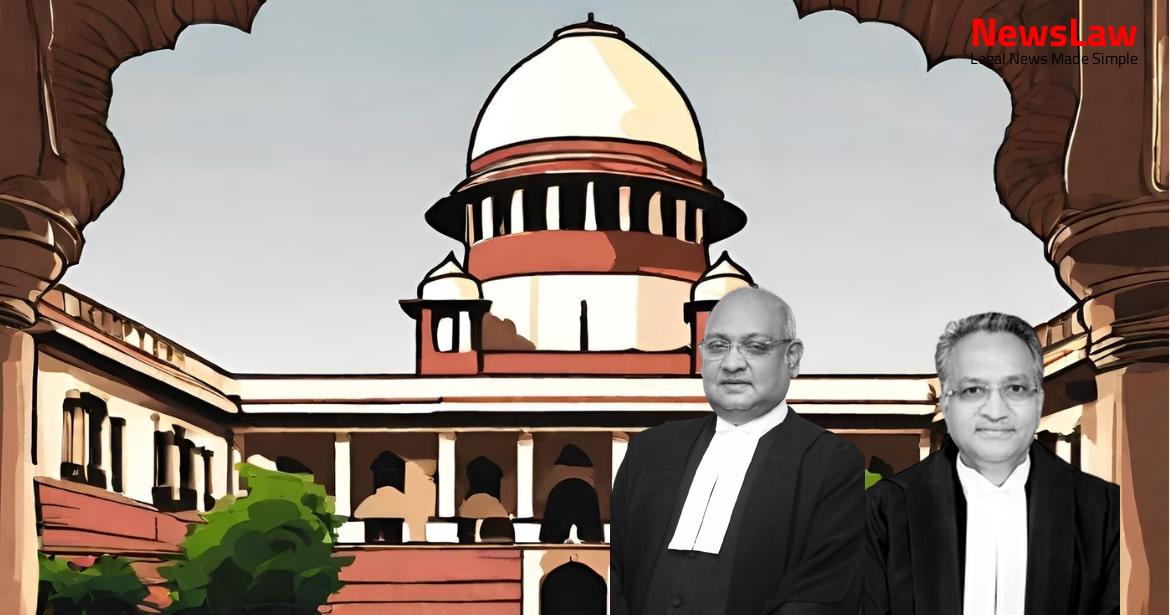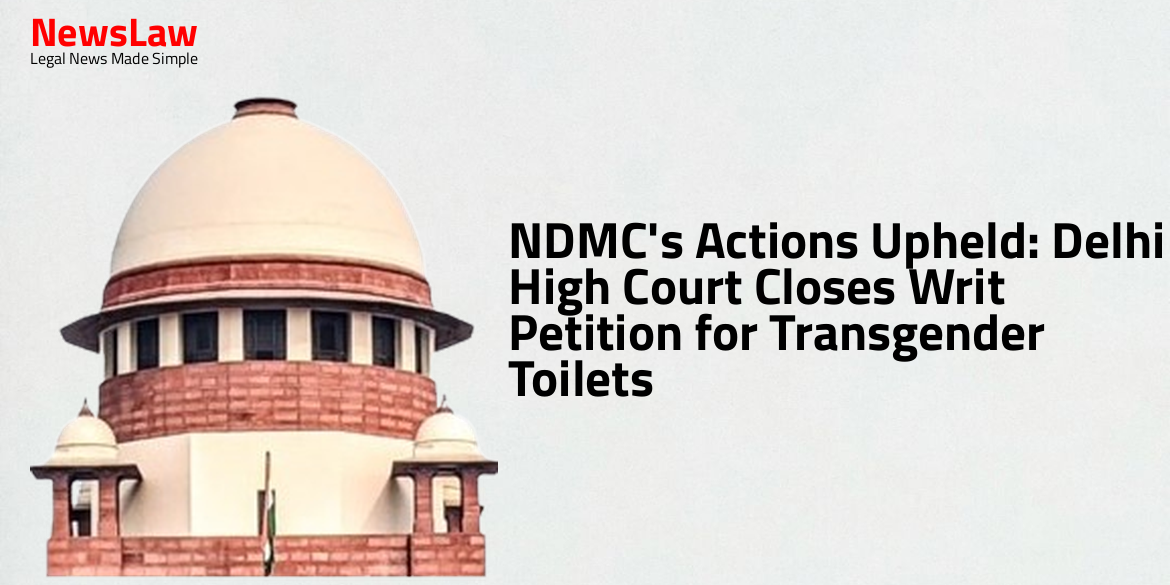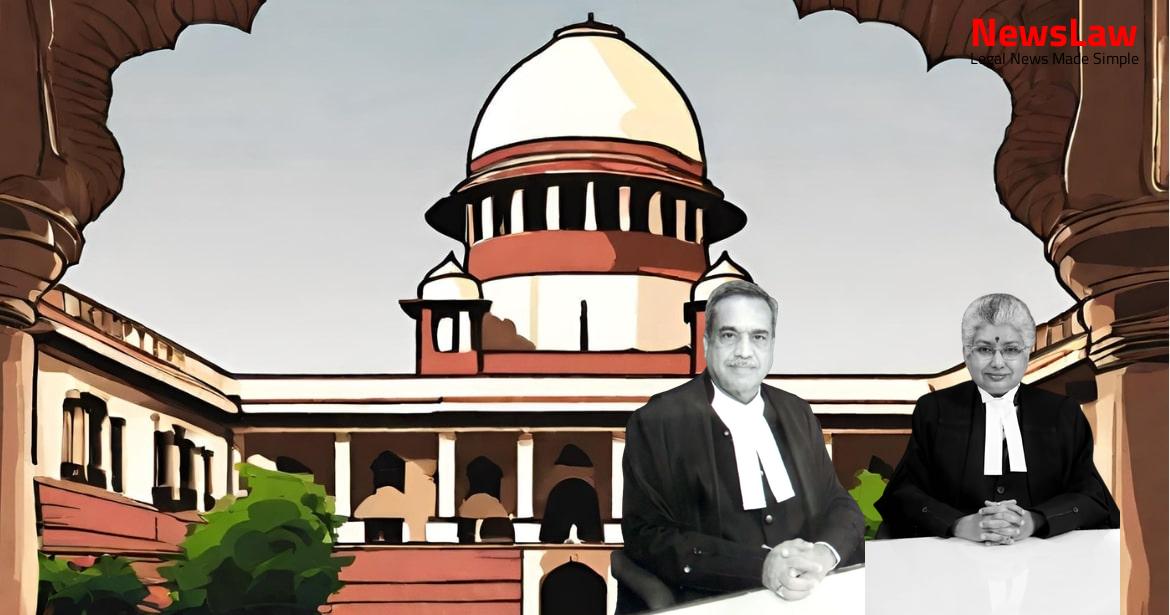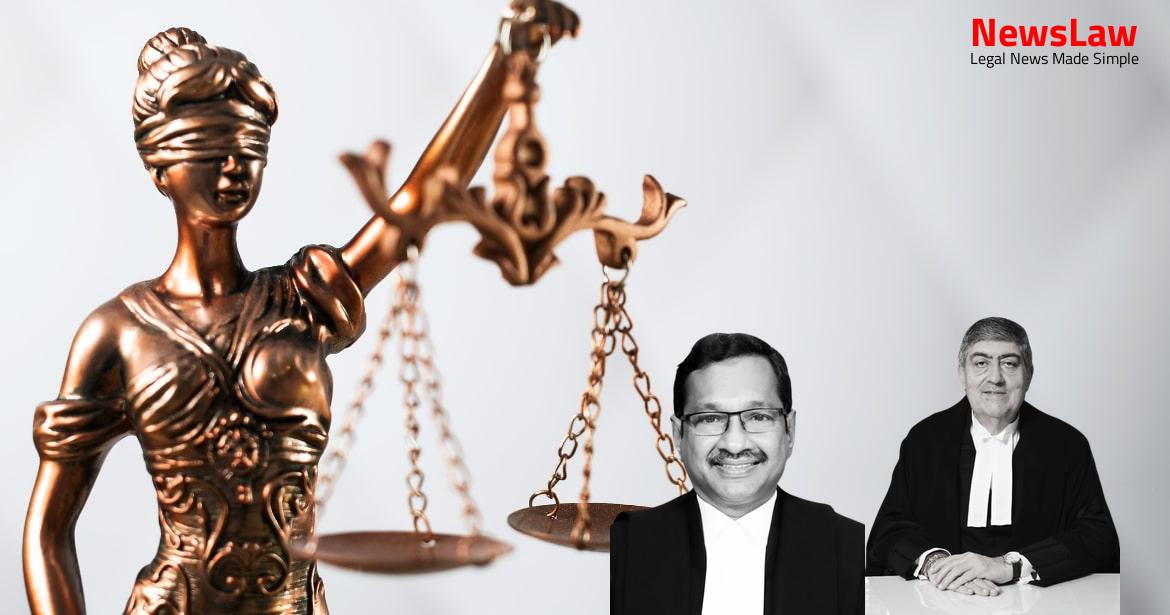In a significant legal case before the Supreme Court of India, a dispute over joint family properties between the parties has led to a detailed examination of evidence and legal arguments. The case involves Original Defendant No.1 asserting sole ownership while Original Defendant No.3 and others claim the properties to be joint family assets. The Court’s decision carries implications for property rights and joint family status. Let’s delve into the details of this noteworthy judgment.
Facts
- The appellant/original defendant No.1 denied that the properties in Schedules A and B belonged to the Joint Hindu family and claimed to be the absolute owner.
- Original defendant No.3 asserted that the suit properties were joint family properties and sought a partition among his children.
- High Court granted liberty to the appellant for an inquiry into the sale of agricultural lands and to pass another preliminary decree if necessary.
- The Trial Court found that the suit properties were joint family properties and the burden shifted to the appellant to prove otherwise.
- Evidence showed joint family involvement in businesses conducted on the properties.
- Trial Court rejected appellant’s claim of sole ownership based on various pieces of evidence.
- Original defendant No.3 supported the stance of the other respondents regarding the joint ownership of the properties.
- Legal representatives of Original defendant No.3, daughters, came on record after his passing.
- Appellant’s review petition was dismissed by the High Court.
- Appellant failed to prove that his business and properties were acquired without aid from the family funds.
- The Trial Court ordered an enquiry into the mesne profits payable to the original plaintiff (respondent No.1).
- The Trial Court ordered partition of the suit schedule properties among the parties, with the appellant, original plaintiff, and original defendant No.2 each getting a 5/12 share, and the remaining share going to original defendant Nos.3 to 5.
- The High Court noted the argument by the original plaintiff that property purchases in the name of the appellant were during the joint family status.
- The Trial Court found in favor of the original plaintiff on all issues, stating that the appellant did not claim partition or separation from the joint family and had pleaded for a 1/4 share in other ancestral property.
- The High Court upheld the Trial Court’s findings in regard to the properties in Schedules A and B of the plaint.
- The Trial Court found evidence of a prior partition by the village panchayat, indicating the joint family status of the parties.
- The Trial Court relied on judgments stating that property acquired by a member from the joint family nucleus would be presumed joint family property if it could have only been acquired with family aid.
- The appellant appealed to the High Court against the Trial Court’s decision.
Also Read: Balancing Justice: Case Summary of C.P. No. 16/2017
Issue
- The Trial Court framed several issues based on the pleadings of the parties.
- One of the significant issues was whether the plaintiff and defendants are members of a Hindu Joint family.
- Another key issue was whether the suit schedule properties were purchased by the defendant (Original Name) in the name of defendant (Original Name) from joint family funds.
- Additionally, the court needed to determine if the suit properties were self-acquired properties of defendant (Original Name).
- The final issue was to decide the appropriate order or decree to be issued in this case.
Also Read: Redefining Pre-Deposit Requirements: Ideal Detonators Pvt. Ltd. v. Commercial Tax Officer
Arguments
- The appellant’s counsel argues that the High Court dismissed the first appeal without discussing the evidence presented by the parties.
- Argument made against the Trial Court’s decision to put the burden of proof on the appellant to establish the existence and adequacy of a nucleus.
- Reference made to various judgments to support the appellant’s contentions.
- The respondent’s counsel contends that evidence shows the family lived as an undivided joint family and properties were bought using joint family funds.
- Settled law indicates that if a sufficient joint family nucleus is proven, there is a presumption that properties are joint family assets.
- Citing Appasaheb Peerappa Chamdgade case to support the shift of burden to individual to prove property acquisition without aid of joint family nucleus.
- The business from the properties was established as a joint family business run with joint family funds.
- Failure of the appellant to challenge the evidence provided by the respondent regarding joint family nucleus.
- No pleading or proof from the respondent concerning the adequacy of the joint family nucleus to fund property purchases.
- Absence of presumption of joint ownership in this case due to lack of evidence regarding joint family nucleus.
- Urging that crucial evidence was overlooked by both courts, showing the appellant used personal funds to purchase the properties, making him the absolute owner.
- Reliance placed on V.D. Dhanwatey Vs. Commissioner of Income Tax, M.P., Nagpur for the same proposition.
- The High Court upheld the finding of fact recorded by the Trial Court, convinced of its just and proper nature.
- High Court did not need to restate the evidence effect or reiterate Trial Court reasons as per Santosh Hazari Vs. Purushottam Tiwari and U. Manjunath Rao Vs. U. Chandrashekar and Another.
- After considering elaborate arguments and evidence, the parties are relegated to the High Court for fresh consideration of the first appeal.
Also Read: Interpreting Section 14 of the 2002 Act: Equivalence of CJM and CMM
Analysis
- The appellant raised formidable issues on facts and law that require proper attention of the High Court under Section 96 of CPC.
- Mere concurrence with the trial court judgment does not meet the legal requirement.
- The first appellate court cannot simply quote passages from the trial court judgment and state agreement without giving reasons.
- The purpose of referring to a specific case was to show that a letters patent appeal was not restricted to questions of law.
- The first appellate court must have a defined role in considering both facts and evidence, reflecting reasons for agreement with the trial court.
- There must be an expression of opinion by the first appellate court, not a mere reproduction of submissions.
- The High Court in this case disposed of the first appeal in a cryptic manner, merely affirming the trial court opinion without proper analysis.
- Relegating parties before the High Court for fresh consideration of the first appeal is sometimes necessary for a thorough review.
- Expression of general agreement with reasons in the trial court judgment should be sufficient but not a camouflage to avoid duty.
- In the recent decision of this Court in U. Manjunath Rao, the Court emphasized the right of parties to be heard on both questions of fact and law in the first appeal.
- The first appellate court is required to address all aspects and decide the case with reasons.
- In a separate recent decision in C. Venkata Swamy, the settled legal position regarding the power and duty of the appellate court under Section 96 of the Code was reiterated.
- The appellate court must consider decisions in Kurian Chacko, Santosh Hazari, H.K.N. Swami, Jagannath, B.V. Nagesh, S.B.I., and Union of India while deciding the first appeal.
- The three-Judge Bench decision in Asha Devi v. Dukhi Sao is relevant although the context was different.
- Order 41 Rule 31 CPC was referred to in the context of power of the Division Bench hearing a letters patent appeal from the judgment of the Single Judge in a first appeal.
- The Court held that the letters patent appeal lies on both questions of fact and law.
- The judgment of the appellate court must be in writing and state the points for determination, the decision thereon, the reasons for the decision, and the relief to which the appellant is entitled.
- The first appellate court must analyze the entire evidence presented by the parties and express its opinion within its jurisdiction.
- It is important for the High Court to analyze and arrive at conclusions based on the evidence provided by both parties.
- The judges in this case do not express any opinion on the merits of the case, leaving it to be determined by the High Court.
- The appellant has raised concerns about important documents not being exhibited during the trial, which the High Court needs to address.
Decision
- The High Court shall decide the first appeal without being influenced by any observations in the impugned judgment.
- The appeals are allowed with no costs imposed.
- The remanded first appeal from 2002 should be handled expeditiously by the High Court.
- All pending applications are disposed of.
- The impugned judgment and decree, along with the orders dated September 7, 2004, and September 27, 2006, from the High Court of Karnataka at Bangalore are set aside.
- RFA No. 456 of 2002 is remanded to the High Court with the given directions.
Case Title: R.S. ANJAYYA GUPTA Vs. THIPPAIAH SETTY
Case Number: C.A. No.-007418-007418 / 2009



